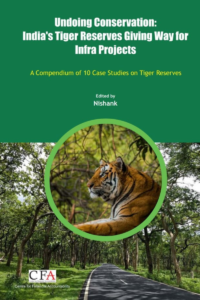A Compendium of 10 Case Studies on Tiger Reserves
 India’s burgeoning economic growth in the last two decades, especially in the infrastructure sector, has heavily impacted its forests and protected areas. Not only has there been a diversion of large tracts of forest land for non-forest purposes, but various infrastructure projects such as roadways, railways, transmission lines, irrigation projects, mining, etc. have also been allowed near or within protected areas, jeopardizing their flora and fauna in the process and negating efforts towards the conservation of important species.
India’s burgeoning economic growth in the last two decades, especially in the infrastructure sector, has heavily impacted its forests and protected areas. Not only has there been a diversion of large tracts of forest land for non-forest purposes, but various infrastructure projects such as roadways, railways, transmission lines, irrigation projects, mining, etc. have also been allowed near or within protected areas, jeopardizing their flora and fauna in the process and negating efforts towards the conservation of important species.
Among protected areas, tiger reserves are the most vulnerable lot. They have incidentally witnessed some of the largest projects being pushed through. Several large scale projects have been put on hold only due to the timely intervention of citizens and environmentalists. This has happened despite the government’s repeated proclamation of the importance of saving tigers. A large number of big and small linear infrastructure projects, along with other developmental projects, are being allowed to come up within and in the vicinity of tiger reserves. Several of these projects pose an existential threat to the flora and fauna in the regions where the tiger reserves are located, along with endangering the existing tiger population.
In order to grasp the extent of infrastructure projects coming up within and near protected areas, earlier, the Centre for Financial Accountability had published a Mapping Report titled “Rise in Infrastructure Projects in Protected Areas: A Self-Defeating Goal for Development”. This report carries extensive data on projects near and within protected areas, including tiger reserves, which had either been given or had applied for clearances in the past few years. In order to build a deeper understanding of the impacts of infrastructure projects on protected areas, the current compendium presents case studies focusing on ten tiger reserves spread across the length and breadth of India. It provides key insights into the range of controversial projects which have either come up in these reserves or were planned but have been stalled. The ten tiger reserves covered in this compendium are: Pakke Tiger Reserve, Arunachal Pradesh; Kaziranga National Park and Tiger Reserve, Assam; Bandipur Tiger Reserve, Karnataka; Kali Tiger Reserve, Karnataka; Parambikulam Tiger Reserve, Kerala; Panna Tiger Reserve, Madhya Pradesh; Tadoba Andhari Tiger Reserve, Maharashtra; Mukundra Hills Tiger Reserve, Rajasthan; Amrabad Tiger Reserve, Telangana; and Rajaji Tiger Reserve, Uttarakhand. Some of the key projects covered in this compendium include the Ken-Betwa River Interlinking Project passing through the Panna Tiger Reserve; a shelved uranium mining project in the Amrabad Tiger Reserve; the Anakkayam Hydel Electric Power Project in the Parambikulam Tiger Reserve; the stalled Hubbali-Ankola Railway Project passing through the Kali Tiger Reserve (which would have led to the felling of 2.2 lakh trees in the fragile Western Ghats); and a 40 km-long stretch of highway proposed through the Pakke Tiger Reserve. There are many other similar infrastructure projects which have been highlighted in this compendium.
Rather than analyzing the detrimental effects of a single project in the context of any particular tiger reserve, juxtaposing the impacts of multiple projects in tiger reserves gives insights into threats posed on a cumulative basis, enabling us to assess the gravity of the situation holistically. The aim of these case studies is not only to analyze how the existing tiger population may be impacted due to various projects, but also to help see these tiger reserves as rich but fragile biodiversity hotspots home to several species of plants and animals, including several endangered species. These case studies provide a rich source of information for the reader and will give a better sense of the direction in which we are headed in terms of conservation in general and tiger conservation in particular.
The case studies collectively also delve into the larger question of choosing between the anthropocentric approach and the eco-centric approach as the way forward in protecting our protected areas. Clearances for infrastructure projects, such as the widening of National Highways cutting through tiger reserves, have often been provided by authorities to allow the faster movement of people and goods through these areas, with an aim to ‘benefit’ the people and the economy. However, such actions come at the price of causing irreversible damage to wildlife and forests. Protected areas such as tiger reserves are natural habitats that are a culmination of evolutionary processes spanning millions of years. The unique biodiversity of protected areas cannot be sacrificed unquestioningly at the altar of ‘development’, and decisions taken by authorities need to undergo larger public scrutiny. Ongoing discussions on factoring in the ‘ecological costs’ involved in the implementation of infrastructure and developmental projects, therefore, are in urgent need of greater attention.
Read and download the resource here: Undoing Conservation India’s Tiger Reserves Giving Way for Infra Projects – A Compendium of 10 Case Studies on Tiger Reserves
Centre for Financial Accountability is now on Telegram. Click here to join our Telegram channel and stay tuned to the latest updates and insights on the economy and finance.
